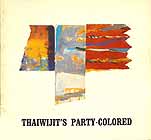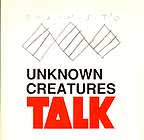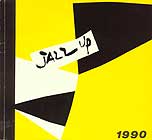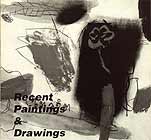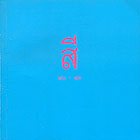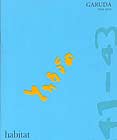|
THAIWIJIT'S PARTI-COLORED, 1987 Catalogue of Thaiwijit's Parti-colored Exhibition, 1987 |
|
UNKNOWN CREATURES TALK, 1989 Catalogue of Thaiwijit's Unknow creatures talk Exhibition, 1989 |
|
JAZZ UP, 1990 Catalogue of Thaiwijit's Jazz up Exhibition, 1990 |
|
Recent Paintings & Drawings, 1991 Catalogue of Thaiwijit's Recent Paintings & Drawings Exhibition, 1991 |
|
Artist's Color, 1993 To label or categorize a piece of art is dangerous. Often having a negative rather than positive result. As for the work of Thaiwijit, only by some facial characteristics, ie., a trace of solid intense color or some arbitrary brush stroke, can we put his work into a file of ...ism? To label an art piece is a minor factor in appreciating art work. Most important is how we really recognize the hidden value of the work. There are many approaches to the appreciation of Thaiwijit's work. Viewed simply, as a practiced painter. His color and form are excellent. Who could deny the great pleasure from concentrating on the effects of such elements working together on Thaiwijit's canvases? It's an incomparable journey into the world of color. If you don't have color-blind eyes. Another method is to follow your imagination, thinking about his action in front of the canvases. We can see lots of evidence as proof of Thaiwijit's performance. A large color field contrasting to a small detail of texture. A solid deliberate line against a hlurred background. How exciting to see the motion. The contrast between fast and slow. To compare the results of seemingly random and intentional mixture of color. To investigate the activity motivated by instinct and mind. This is a great work of action in space. Not a good work of craftsmanship. The scholarly approach is not the recommended method for understanding Thaiwijit's art. You don't have to be a professor to understand his work. Considerations based upon analytical data are easily misleading and in contrast to the intentions of the artist. Not the way to the appreciation of his work. If you know the words ABSTRACT or ABSTRACT EXPRESSION before you are acquainted with the works of art, you may make a mistake, borrowing an instant label to wrongly stamp on a piece. We need to have clear information about an artists art and his life before we can make such decisions. In what terms then can we evaluate and describe Thaiwijit's work? The key is Iying in his own words. "I'm an ordinary person." His painting is a reflection of a life which is very human. Not a life of dramatic tragedy, of a suffering artist. This may disappoint those who want to adore "The Artist Idol". Who are happy to see their artist live in a broken world, an unsustainable situation, dying before attaining success. In contrast, Thaiwijit strives to live in the simplest conditions he can achieve. Avoiding stress, rules and self- centeredness. If you realize that to be simple is to follow. The cosmic law, you may agree and are likely to add some philosophic approach to understand this artist. |
|
Color, 97 - 98 Catalogue of Thaiwijit's Color 97 - 98 Exhibition, 1998 |
|
Rapture, 2001 When I was a child it was bliss to be able to watch puffs of clouds floating in the sky. As they flowed they would break up and then re-group into different kinds of shapes. Unfamiliar yet definite in their forms, their rhythm struck my eyes differently every time thus creating many new feelings in me. Sometimes these forms looked like organisms evolving through stages of time, or they floated away like animals on the move; sometimes they were undefined and enormous and seemed to me as if they enclosed some hidden powers. Sometimes this process of distortion was overwhelming for my young mind. Yet at other times the feelings were subdued and calm. Experiencing such childhood interpretations from the observation of multitude cloud formations, the phenomenon saturated my imagination with new visions of colours and forms. As my body grew physicaly, my mind developed due to all the information and knowledge I was acquiring through education, much of which, I thought however, could confine my "SPATIAL" dreams. The pure and enthusiastic imagination of a young mind could be diluted by growing up according to the rules of an educated society - sometimes I feared that day - by - day the forces of creativity could become less and less able to drive my imagination beyond it's horison as before. My creative ideas and dreams have come a long
way since then and in recent years meditation has helped me translate
my vision into objects. Selecting, combining and assembling found
and used objects - thereby creating a new object with it's own
identity, both functional and visual - is the result of my childhood
impressions from observing the organic forms of clouds moving
across the sky. |
|
Rapture, 2001 Thaiwijit's Symbol of Beauty I feel very honored to have been asked by Thaiwijit to write an essay about his work for this book. At the same time, however, I also feel uneasy with the task. The reason being that Thaiwijit is a much more experienced artist, and more successful commercially, than I am. With his talent in the field of abstract art, combined with the discipline and constant experimentation with different mediums of expression, Thaiwijit has been a good role model and an important influence on younger artists, including myself. But his aura doesn't make me as uncomfortable as does our basic philosophical differences in art making. I have the basic belief that art is merely a process of understanding the truth of nature and therefore, in my work, I put emphasis more on the conceptual process than in aesthetics. On the contrary, Thaiwijit creates the kind of art that is founded on the importance of aesthetic values, the products of visual elements consisting of line, color, tone, texture and space, integrated with the inner emotions that dictate the creative act according to the artist's personal taste. When I began to think about composing this essay, the first question that sprang to my mind was: is there enough value in the work of art that is simply created for the sake of aesthetics and have no direct concerns toward social issues such as politics, religion, morality? And how is this kind of art different from such commercial-based industry as product design? Such questions gave me the opportunity to exchange thoughts with a close friend who has good knowledge of art history. He suggested that Thaiwijit's work is a kind of art dealing with aesthetic values in a similar manner as those in Formalism and Surrealism, as well as in later artistic movements such as Constructivism, Abstract Expressionism, Minimalism, Color Field Painting, etc. Artists associated with such movements, among others, were Kazimir Malevich, Jackson Pollock, Donald Judd, etc. It is 'art for art's sake' that is, non-representational. It is art concerned with visual elements such as line, color, tone, shape, texture and space; art that emphasizes form and its direct physical and material value. Surrealism was an attempt to relate emotional experiences to the subconscious, then expressing them symbolically, such as in the works by Roberto Matta and André Masson, or in the case of the representational styles, in the works by Salvador Dali and René Magritte. After I'd gathered more information, I was more informed about the similarities and the differences between Thaiwijit's creative style and the artistic tradition of Formalism. Then I began to understand the similarities and differences between our works. In his exhibition, "Rapture", Thaiwijit's works, be it paintings, sculptures, drawings, lamps, vases, flower pots, tables, chairs, all created from found and used materials such as scraps of wood, ceramic bits, pieces of paper that have been soiled with paint. Diverse materials of diverse functions have been transformed and reconstructed with the right amount of artistic elements to create the kind of aesthetics that satisfies his inner feelings and emotions. Sometimes combinations of shapes, colors, and textures of found materials can initiate surprising imagination during the creative process. For instance, the artist sees that the shape of a log happens to resemble human legs, so he searches for the arms and the head for it from other objects and assembles them into the human shape in his own style. This kind of creative approach is similar to the Surrealist philosophy. When we look closely at the details of Thaiwijit's sculptures, we feel that painted elements in them, and certain pieces of sculpture can be seen as sources of light. When we look at the paintings, we see sculptural elements from the use of materials that are rich in texture, such as pieces of an old wooden wall or a sheet of rusty steel that has been thickly painted. When we look at his drawings, we cannot separate the works from their frames, because even the frames contain painterly and sculptural qualities. Sometimes it seems as if the drawings are actually only components added to the frames. As for his product design-or "functional objects" as he refers to them- be it the picture frames, lamps, vases, flower pots, tables, chairs, all are constructed using found and used objects in the same creative manner as his paintings and sculptures. When we look at these objects, we also feel the painterly and sculptural qualities in them. The only difference is that they also serve functional purposes. Every time I visit Thaiwijit's home, I get the feeling of comfort and pleasure. I don't know why. It could be the result of our close friendship and his usual welcoming attitude, or perhaps it is because of the beauty that makes up the environment. The walls, ceilings, and floors all look like works of art. Everything in the house is properly placed according to Thaiwijit's taste and aesthetics. I feel that the language we use to describe and categorize things in terms of function becomes limited when used to define Thaiwijit's art works and functional objects, or even his walls and floors. Because all of them were created with the kind of aesthetics that manage to blur the lines that separate them artistically. For this reason, I propose that we unify these creative acts and call it "Thaiwijit's symbol of beauty". Thaiwijit's creative process makes me think of our traditional eastern way of life and its philosophy of the art of living. We do not separate art and life in our daily activities. Tea drinking in Japan, for example, is not simply done to quench thirst but to quench the mind as well. The setup of the tearoom, the painting scroll on the wall, the flower arrangement, even the utensils used to prepare tea, all have been designed harmoniously to direct the ceremony performers to the inner peace hidden within the human nature. It is a kind of meditation. An activity that is a natural part of being human such as breathing becomes more than just a necessity. Breathing can be practiced as an exercise for the mind, perfecting control of emotions and thoughts and creating peace for the body and the soul. All this blossomed from the Buddhist way of thinking, evident especially in the philosophies of Zen and Taoism. It promotes the idea of 'oneness' beyond the dualistic separation between physical representation and abstraction, self and others, good and evil, right and wrong, living and non-living. all are part of nature, emptiness! Whether he is aware of it or not, the fact that Thaiwijit was raised in a culture richly influenced by Buddhist philosophy gives his creative works the sense of constant exploration and development oblivious of his commercial successes. He allows his creative process to be challenged and to grow with the freedom of expression that comes from the heart. Thaiwijit's Symbol of Beauty eliminates the line that divides the art object and the functional object. For Thaiwijit, the importance of art in the relationship between such subjects as religion, morality, politics, sociology, can be expressed through daily life. I now firmly believe that Thaiwijit's Symbol of Beauty has not only impressive aesthetic values, but it is also a symbol representing a beautiful mind. His understanding of nature and aesthetics, the creative acts that are about learning and finding beauty in the ordinary, are all parts of an attempt to connect and expand the mind. To make art a way of life. |
